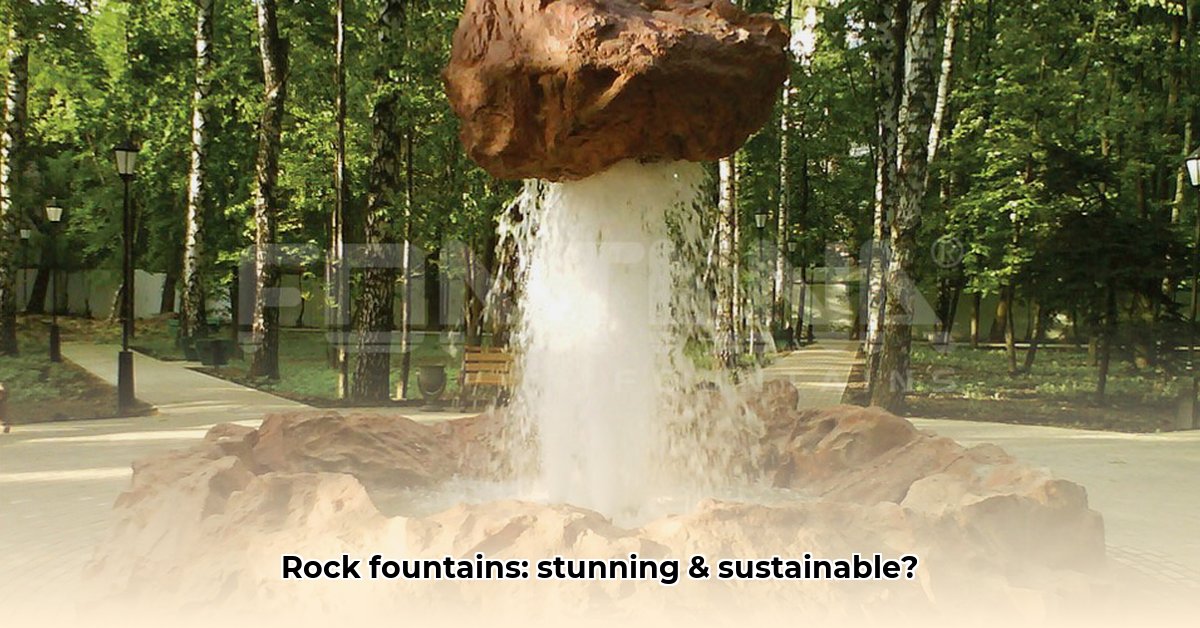Want a gorgeous, relaxing water feature in your yard without breaking the bank or harming the environment? This guide shows you how to choose and install the perfect rock fountain. We’ll cover everything from picking the right size and style for your space to keeping it running smoothly for years. Whether you’re a seasoned gardener or a complete beginner, we’ll ensure you’re confident and informed every step of the way, so you can enjoy your beautiful, eco-friendly rock fountain for years to come. For unique, sustainable materials, consider checking out reclaimed materials.
Rock Fountains: Your Backyard Oasis on a Budget
Dreaming of a tranquil, beautiful backyard but worried about the cost? A rock fountain might be the perfect solution! These stunning water features bring the calming sounds and sights of nature right to your doorstep, transforming your outdoor space into a relaxing retreat. And the best part? You can discover budget-friendly and eco-conscious options without sacrificing style or quality. Let’s explore how to make this dream a reality, while also considering outdoor water feature ideas that complement your rock fountain.
Finding the Perfect Rock Fountain for You
The world of rock fountains is surprisingly diverse. You’ll find everything from small, bubbling tabletop features perfect for a patio or balcony to grand, multi-tiered masterpieces that command attention in a large yard. Before you even start browsing, consider these key factors:
- Your Budget: Rock fountains range in price, from a few hundred dollars to several thousand. Establish a realistic budget early on to narrow your search and prevent overspending.
- Available Space: Measure your space accurately! A large fountain in a small yard will feel cramped, while a small fountain in a vast yard might get lost. Consider the surrounding vegetation and how the fountain will integrate into the existing landscape.
- Your Style: Do you prefer a sleek, modern look with clean lines, or something more rustic and natural with a rugged texture? The style of your fountain should complement your existing landscaping, architecture, and personal taste.
Material selection is also crucial! Natural stone, such as granite, limestone, or slate, exudes a timeless, organic feel, but it often comes with a higher price tag and requires more maintenance. Cast stone offers similar aesthetics but with greater design flexibility and often at a lower cost. GFRC (Glass Fiber Reinforced Concrete) is another excellent option, known for its durability, lightweight construction, and wide array of finishes. Consider the long-term durability and weather resistance of each material in your specific climate.
Installation: DIY or Call in the Pros?
Installing a rock fountain yourself is definitely feasible, especially for simpler, smaller designs. Many retailers provide detailed instructions, online tutorials, and even offer complete kits for beginners. Think of it like assembling a piece of flat-pack furniture – if you’re comfortable with basic tools and following instructions, you can probably manage.
However, for more intricate setups, larger fountains, or projects involving complex plumbing or electrical work, hiring a professional installer is a wise investment. Professionals have years of experience and the right tools to ensure everything is installed correctly, minimizing the risk of leaks, malfunctions, or other costly problems down the line. They can also advise on optimal placement and maintenance strategies.
Here’s a quick comparison to help you decide:
| Feature | DIY Installation | Professional Installation |
|---|---|---|
| Cost | Lower initial investment; savings on labor costs. | Higher upfront cost due to labor fees, but potentially saves money long-term by preventing errors and ensuring proper setup. |
| Time | Significantly more time-consuming; may require multiple attempts and troubleshooting. | Quicker installation time; professionals have the expertise to complete the job efficiently. |
| Expertise | Requires some technical skill, patience, and the ability to follow instructions carefully. | Ensures proper installation, adherence to building codes, and reduces the potential for future problems. |
| Warranty | Usually limited or no warranty provided on the installation itself; manufacturer’s warranty may be voided by improper installation. | Often includes a warranty on the labor and materials, providing peace of mind and protection against defects or malfunctions. |
Keeping Your Rock Fountain Sparkling: Easy Maintenance Tips
A little regular maintenance goes a long way in keeping your rock fountain looking beautiful, functioning smoothly, and preventing costly repairs. You’re essentially just keeping it clean, preventing algae growth, and protecting it from the elements. Think of it like regular car maintenance—preventative care is much easier and cheaper than fixing a major breakdown later.
Regular cleaning is essential to prevent algae growth and keep the water crystal clear. Algae thrives in sunlight and stagnant water, so regular cleaning is crucial. Most fountains need a simple scrub with a soft brush and a water change every few weeks, depending on the local climate and water quality. For colder climates, winterization is essential to prevent damage from freezing temperatures. This typically involves draining the water completely, disconnecting and storing the pump indoors, and covering the fountain to protect it from ice and snow.
Consider using a fountain cover during periods of heavy rain or snowfall to minimize debris accumulation. Regularly inspect the pump for clogs or damage and clean it as needed. Use a fountain cleaner specifically designed for water features to prevent mineral buildup and maintain water clarity.
Budget-Friendly and Eco-Conscious Choices: Making it Green
Rock fountains can be both budget-friendly and environmentally responsible. Look for energy-efficient pumps – many modern pumps use very little electricity, roughly the same as a small LED lightbulb. Some even include variable frequency drives (VFDs), which allow you to fine-tune the water flow and conserve even more energy by adjusting the pump speed to match your desired water flow rate.
Choosing sustainable materials, such as reclaimed stone, recycled materials, or locally sourced stone, is another excellent way to minimize your environmental impact. Consider the embodied energy in the materials used to construct the fountain. Remember, investing in a durable, high-quality fountain made from sustainable materials now means fewer repairs and replacements later, saving you money and reducing waste in the long run. Did you know that energy-efficient pumps can reduce energy consumption by up to 60% compared to traditional pumps?
Why Choose a Rock Fountain? The Benefits Beyond Beauty
Beyond their undeniable aesthetic appeal, rock fountains offer several surprising advantages that enhance your well-being and your property:
- Stress Relief: The gentle, soothing sounds of flowing water are incredibly calming and therapeutic, reducing stress and promoting relaxation. It’s like having a mini-spa in your own backyard! The sound masks unwanted noise.
- Increased Home Value: A well-maintained rock fountain can significantly boost your property’s curb appeal, making it more attractive to potential buyers and potentially increasing its value.
- Enhanced Outdoor Living: It instantly transforms your outdoor space into a peaceful, inviting sanctuary, perfect for relaxing, entertaining, or simply enjoying nature. Imagine relaxing with a book or enjoying a glass of wine by your own personal waterfall. A 2023 study by the National Association of Realtors indicated that thoughtfully designed water features can increase property values by as much as 15% in some markets.
- Attracting Wildlife: Rock fountains can attract birds, butterflies, and other beneficial wildlife to your yard, creating a vibrant and ecologically diverse environment.
Investing in a rock fountain is an investment in your well-being, the beauty of your home, and the environment. With a little research and careful planning, you can enjoy a stunning, budget-friendly, and environmentally conscious water feature for many years. So, start planning your backyard oasis today using water fountain features!
How to Choose the Best Low-Maintenance Outdoor Water Fountain for My Climate
Key Takeaways:
- Selecting the ideal water fountain requires balancing aesthetic preferences with practical considerations specific to your climate.
- Your climate’s conditions, like freezing temperatures and intense sunlight, significantly impact material durability.
- Low-maintenance options prioritize durable, weather-resistant materials and simple designs.
Understanding Your Climate’s Impact
Before browsing fountain catalogs, understanding your local climate is vital. How to choose the best low-maintenance outdoor water fountain for my climate starts with honestly assessing its harshest conditions. Do you experience freezing winters with frequent freeze-thaw cycles? Scorching summers with intense UV radiation? High winds that can carry debris? Frequent rainfall that promotes algae growth? These factors directly influence material choice, fountain design, and overall longevity. A fountain that thrives in the arid climate of Arizona might quickly deteriorate in the rainy, cold climate of Maine.
Material Matters: Durability and Maintenance
The material of your fountain dramatically impacts its longevity and the amount of maintenance required. Natural stone, while beautiful and timeless, may require sealing against frost damage in colder climates to prevent cracking and spalling. Resin is a popular, relatively low-cost alternative, often resistant to cracking, fading, and algae growth. Metal fountains, especially those made of high-quality stainless steel or powder-coated aluminum, are durable but may rust if not properly treated or if the coating is damaged. Fiberglass can be a good mid-range option, combining resilience with affordable pricing and relatively low weight.
| Material | Pros | Cons | Climate Suitability |
|---|---|---|---|
| Natural Stone (Granite, Slate) | Elegant, highly durable (when properly sealed |
- Gray Kitchen Backsplash Tile: Ideas for a Stylish Upgrade - December 14, 2025
- Backsplash For Gray Cabinets: Choosing the Right Backsplash Style - December 13, 2025
- Gray And White Backsplash: Ideas For Timeless Style - December 12, 2025









